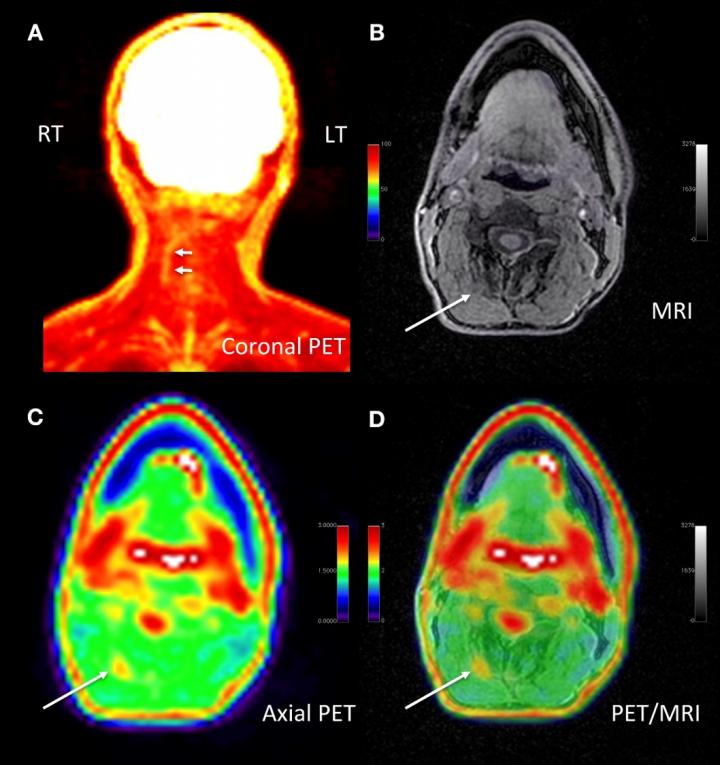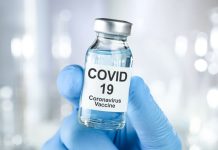
IMAGE: Adult male with decades of right neck pain, discomfort and tightening following birth injury. The patient had failed multiple standard therapeutic maneuvers before presenting for 18F-FDG PET/MR imaging. Images shows…
view more
Credit: Cipriano, et al., Stanford University, CA.
A new molecular imaging approach utilizing 18F-FDG positron emission tomography (PET) and magnetic resonance imaging (MRI) can precisely identify the location of pain generators in chronic pain sufferers, often precipitating a new management plan for patients. This research was presented at the Society of Nuclear Medicine and Molecular Imaging 2020 Annual Meeting.
Pain is the most common reason to seek medical attention, and those who suffer from it outnumber those who suffer from cancer, heart disease and diabetes combined. According to the National Center for Complementary and Integrative Health, chronic pain affects nearly 50 million adults in the United States and costs the nation’s healthcare system as much as $635 billion in total expenses, including imaging and treatment costs.
“In the past few decades, we have confirmed that anatomic-based imaging approaches, such as conventional MRI, are unhelpful in identifying chronic pain generators,” said Sandip Biswal, MD, musculoskeletal radiologist and associate professor of radiology at Stanford University School of Medicine in Stanford, California. “We know that 18F-FDG PET has the ability to accurately evaluate increased glucose metabolism that arises from to acute or chronic pain generators. As such, in our study we examined PET/MRI as a potential solution to determine the exact molecular underpinnings of one’s pain.”
In the study, 65 chronic pain patients underwent 18F-FDG PET/MRI from head to foot. Maximum standardized uptake values and target-to-background ratios were measured using image analysis software. PET/MR images were evaluated by two radiologists to determine if increased 18F-FDG uptake occurred in the site of symptoms or in other areas of the body. Imaging results were then discussed with the referring physician, who determined whether a change in the pain management plan would follow.
Increased uptake of 18F-FDG in affected nerves and muscle was identified at the site of pain and other areas of the body in 58 out of 65 patients. This resulted in a mild modification of management plan (e.g., additional diagnostic test) for 16 patients and a significant modification for 36 patients (e.g., new invasive procedure suggested or ordered). In total, new management plans were implemented for 40 out of 65 patients, which had not been anticipated by the referring physician.
“The results of this study show that better outcomes are possible for those suffering from chronic pain,” said Biswal. “This clinical molecular imaging approach is addressing a tremendous unmet clinical need, and I am hopeful that this work will lay the groundwork for the birth of a new subspecialty in nuclear medicine and radiology. Using this approach will require knowledge and expertise not only in nuclear medicine but also in musculoskeletal imaging, neuroradiology and potentially other fields, such as body imaging and pediatric radiology, where pain syndromes are important clinical problems.”
###
Abstract 399. “18F-FDG PET/MRI of patients with chronic pain alters management,” Peter Cipriano, Daehyun Yoon, Ian Carroll, Catherine Curtin, Vivianne Tawfik, Yingding Xu, and Sandip Biswal, Stanford University, Stanford, California. SNMMI’s 67th Annual Meeting, July 11-14, 2020.
All 2020 SNMMI Annual Meeting abstracts can be found online at http://jnm.
About the Society of Nuclear Medicine and Molecular Imaging
The Society of Nuclear Medicine and Molecular Imaging (SNMMI) is an international scientific and medical organization dedicated to advancing nuclear medicine and molecular imaging, vital elements of precision medicine that allow diagnosis and treatment to be tailored to individual patients in order to achieve the best possible outcomes.
SNMMI’s members set the standard for molecular imaging and nuclear medicine practice by creating guidelines, sharing information through journals and meetings and leading advocacy on key issues that affect molecular imaging and therapy research and practice. For more information, visit http://www.
TDnews














